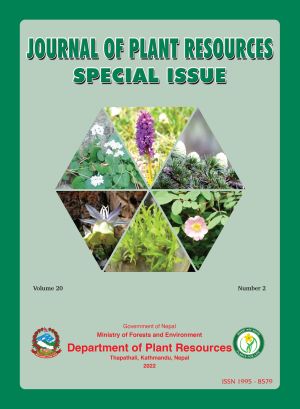Population Structure and Regeneration Status of Pinus-Quercus Mixed Forest in Bhardeu Village, Lalitpur District, Nepal
DOI:
https://doi.org/10.3126/bdpr.v20i2.56977Keywords:
Circular plots, Family, Girth class, Temperate forestAbstract
Understanding population structure and regeneration status reflects the biological and ecological characteristics of the forest. The present study aims to know the population structure and regeneration status of Pinus-Quercus mixed forest in Bhardeu village of Lalitpur district, central Nepal. The study was carried out by laying down twenty-eight concentric circular plots of 8.92-meter radius randomly during 2021-2022. Altogether 28 tree species belonging to 24 genera and 17 families are recorded. Five species (Miliusa velutina, Cinnamomum camphora, Eriobotrya dubia, Maesa chisia and Saurauia napaulensis) were only recorded in adult form. The forest was found to be dominated by the species of Pinus and Quercus with the important value index (IVI) values ranging from 49.91 to 35.24. The average Simpson’s Diversity Index (1/D) is 2.88, Shannon Weiner’s Index is 0.85, species evenness is 0.57 and species richness is 1.07. The overall regeneration of the different species was seedlings 6484 individuals/ha., saplings 533 individuals/ha. and adults 1198 individuals/ha. showing fair regeneration. The majority of tree species show fair regeneration status (32.14%) followed by none regeneration (25%), new regeneration (17.85%), poor regeneration (14.28%) and good regeneration status (10.71%). The density diameter curve of the forest shows slightly flat reverse j-shaped structure indicating that majority of tree species were not in good regenerating status. The present analysis thus revealed that the population structure may get altered in future. Those species with none to poor regeneration status should be prioritized for the conservation and the proper management strategies need to be developed for sustainability of tree species in the forest.




